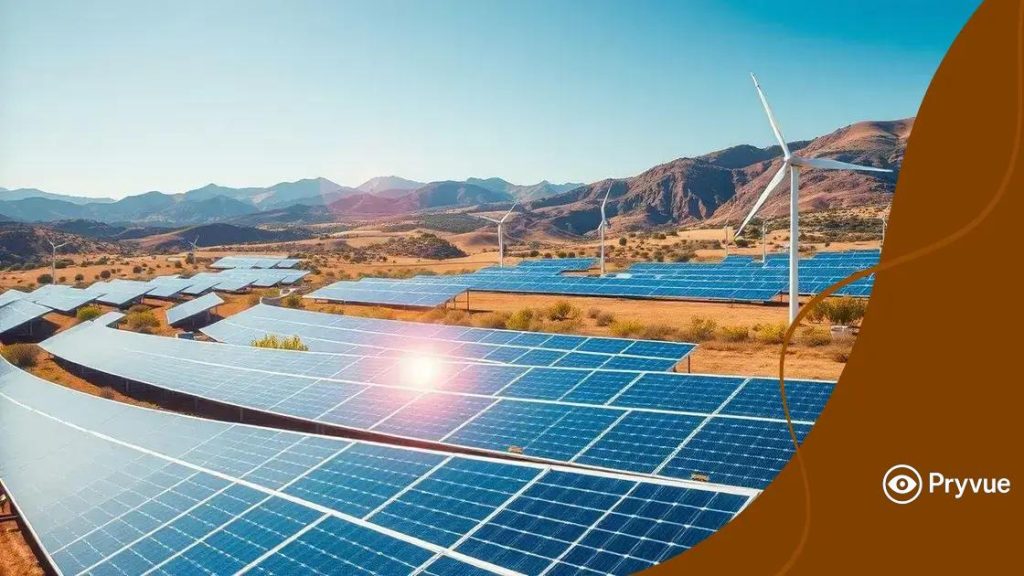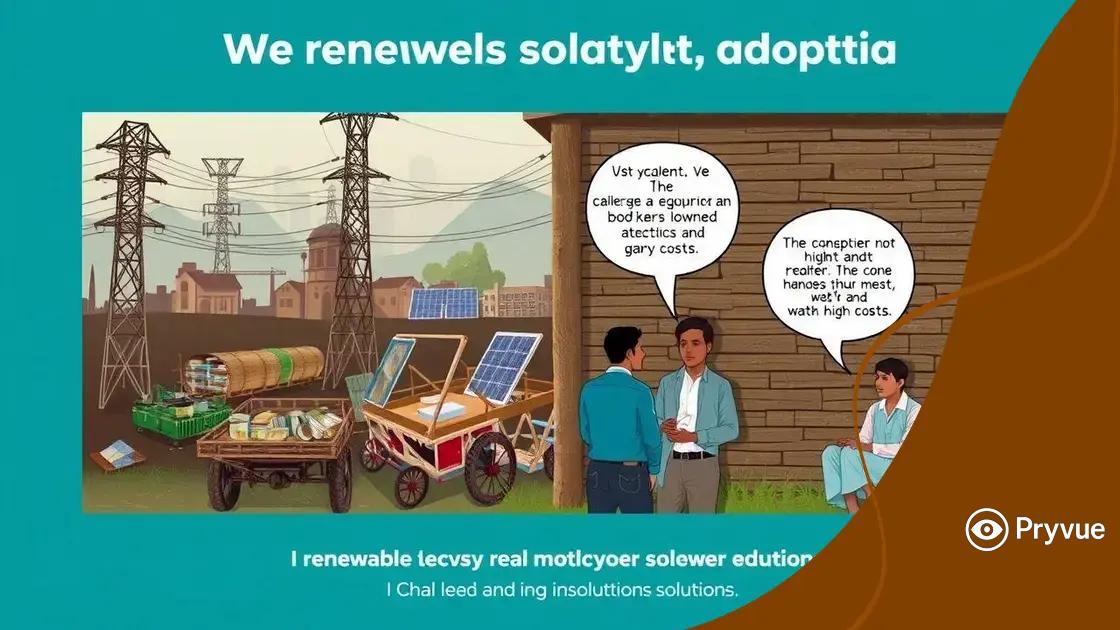The US shift to renewable power sources: a closer look

Anúncios
The US shift to renewable power sources is driving increased energy capacity, job creation, and improved technologies, making clean energy a key component of the future energy landscape.
The US shift to renewable power sources is not just a trend; it’s a movement that reshapes our energy landscape. Have you considered how this impacts your daily life and the environment? Let’s dive into this fascinating transformation.
Anúncios
Current state of renewable energy in the US
The current state of renewable energy in the US has witnessed significant strides. The country is making strides toward a cleaner energy future. With an increasing number of states adopting ambitious policies, renewable energy is becoming a staple in the American power mix.
Renewable Energy Sources
Wind, solar, and hydropower dominate the landscape. Each contributes uniquely to the energy grid, offering sustainable options for electricity generation.
Anúncios
- Wind energy constitutes a large portion of renewable sources, harnessing the power of the breeze.
- Solar energy usage has skyrocketed, with solar panels appearing on rooftops and in solar farms across the nation.
- Hydropower continues to be a reliable source, making use of flowing water to produce power.
- Emerging technologies like geothermal and biomass also play a role in diversifying the energy portfolio.
Transitioning toward these sources has brought about changes in job markets and investment opportunities. Clean energy industries are expanding rapidly, fueling job growth in engineering and manufacturing sectors.
Government Policies and Incentives
Supportive policies at both state and federal levels enhance renewable energy development. Tax incentives and subsidies encourage businesses and homeowners to invest in clean energy solutions.
Moreover, states are establishing goals for renewable energy adoption, aiming for a sustainable future. These measures not only promote energy independence but also help in addressing climate change.
Public awareness is key to driving support for renewable initiatives. As communities become more informed, grassroots movements push for a greener energy agenda, influencing policymakers to adopt favorable policies.
Benefits of transitioning to renewable power
Transitioning to renewable power is not just an environmental necessity; it also brings numerous benefits for society and the economy. By tapping into sources like wind, solar, and hydropower, we can pave the way for a sustainable future.
Economic Advantages
One of the most compelling reasons to shift to renewable energy is the potential for economic growth. Investing in renewable technologies creates jobs in various sectors, from engineering to installation. These jobs often pay well and cannot be outsourced.
- Job creation: Renewable energy sectors employ millions, with more jobs expected as technologies advance.
- Energy independence: Reducing reliance on fossil fuels can stabilize energy prices and enhance national security.
- Long-term savings: While the initial investment may be high, renewable energy sources typically have lower maintenance and operational costs.
Additionally, many states are implementing policies that favor renewable energy development, boosting local economies and attracting businesses seeking greener solutions.
Environmental Impact
Another crucial benefit of transitioning to renewable power is the positive impact on the environment. By minimizing greenhouse gas emissions, we can slow down climate change and improve air quality.
Renewable sources produce little to no pollution, making them much cleaner than fossil fuels. For instance, solar panels harness sunlight without emitting harmful gases, while wind turbines convert wind into energy without creating waste.
Sustainable energy also conserves natural resources, ensuring that future generations have access to clean environments. As a society, we can foster biodiversity and protect ecosystems by embracing renewable energy solutions.
The shift is more than just an energy choice; it is a pathway to a healthier planet. As awareness increases, communities can engage and promote the adoption of these clean technologies.
Challenges facing renewable energy adoption

Despite the many benefits of renewable energy adoption, several challenges remain that can hinder progress. These obstacles must be addressed to fully realize the potential of clean energy.
Infrastructure Limitations
One significant challenge is the existing energy infrastructure. Many regions still rely heavily on traditional fossil fuels. Upgrading power grids to accommodate renewable sources can be complex and expensive.
- Grid integration: Integrating intermittent sources like wind and solar into the grid requires advanced technology.
- Storage solutions: Effective energy storage systems are necessary to ensure a steady supply, especially when the sun isn’t shining or the wind isn’t blowing.
- Transmission lines: Expanding transmission capabilities is essential to transport renewable energy from generation sites to consumers.
Additionally, the current infrastructure may not support the rapid uptake of renewable resources, especially in rural areas where development is slower.
Economic Factors
Economic barriers also pose challenges to the shift toward renewable energy. Initial costs for renewable technologies can be high, deterring investment.
Many consumers and businesses remain hesitant to switch away from established fossil fuels due to concerns about this up-front expense. Government incentives may help, but they can be inconsistent.
Moreover, international competition can impact prices. If countries do not invest in renewable energy, it can lead to higher costs for nations that do.
Public perception plays a role as well. Misinformation about renewable energy and its efficiency can cloud public opinion and slow adoption. Building awareness and understanding is crucial in overcoming these obstacles.
Collaborative efforts from governments, businesses, and the public are necessary to address these challenges. Working together can lead to innovative solutions and pave the way for a more sustainable future.
Innovative technologies in renewable energy
Innovative technologies in renewable energy are changing the way we harness natural resources. These advancements make renewable sources more efficient, accessible, and effective for everyday use.
Advanced Solar Technologies
Solar energy has seen significant innovation. New materials such as perovskite solar cells are emerging, offering better efficiency at a lower cost.
- Solar panels have become lighter and more efficient, allowing for easier installation on various surfaces.
- Building-integrated photovoltaics (BIPV) merge energy generation with building materials, like windows.
- Concentrated solar power (CSP) systems utilize mirrors to focus sunlight and generate heat, powering turbines to create electricity.
These advancements mean more households and businesses can adopt solar technology, leading to an increase in renewable energy adoption.
Wind Energy Innovations
Wind energy technology is also evolving rapidly. Modern wind turbines are taller and have larger blades, increasing their energy output.
Offshore wind farms are gaining traction, utilizing the strong winds available over the ocean. These farms can produce significant amounts of energy with minimal visual impact from land.
Moreover, floating wind turbines can be placed in deeper waters, expanding the potential for energy production in many regions.
Energy Storage Solutions
Energy storage is critical for maximizing the use of renewable sources. Advanced batteries, such as lithium-ion and flow batteries, are becoming more efficient and cost-effective.
These solutions allow excess energy generated during peak production times to be stored and used during demand spikes. This ensures a stable energy supply even when renewable sources fluctuate.
Additionally, technologies like pumped hydro storage and compressed air are being developed to enhance energy resilience.
Innovative technologies in renewable energy not only promise to enhance efficiency but also lay the foundation for a more sustainable and resilient power grid.
Future predictions for US renewable energy
The future of renewable energy in the US looks promising as technological advancements and public interest grow. Predictions suggest a significant shift towards cleaner energy sources within the next few decades.
Increased Renewable Capacity
Experts anticipate that the capacity for renewable energy will continue to expand dramatically. Wind and solar power are expected to lead the charge, taking up more space in the energy mix.
- Solar power could generate 30% of the US electricity by 2030, thanks to falling costs and improved efficiency.
- Wind energy production is projected to double, with numerous offshore wind farms being developed.
- As battery technology improves, energy storage will become more efficient, making renewable energy more reliable.
The rise in capacity will not only assist in meeting energy demands but will also support job growth in the renewable sector.
Policy Support and Investment
Government policies will play a crucial role in shaping the future of renewable energy. Increased federal and state incentives are likely to promote investments in clean energy initiatives.
More businesses and homeowners will take advantage of tax credits and grants, facilitating the adoption of solar panels and other renewable technologies. These policies aim to create a favorable environment for sustainability, pushing towards net-zero emissions by mid-century.
Additionally, public and private sectors are expected to collaborate more closely, leading to innovative financing solutions that make renewable technologies accessible to all.
Impact on the Job Market
The renewable energy sector is projected to become a significant job creator. As more projects are launched, a wide range of positions will be available, from research and development to installation and maintenance.
According to estimates, employing over a million workers in the renewable sector by 2030 is feasible, boosting local economies and ensuring a more stable job market.
This transformation not only addresses energy needs but also fosters a workforce skilled in emerging technologies.
The future of renewable energy in the US embodies a commitment to sustainability, innovation, and economic growth, making it a priority for generations to come.
FAQ – Frequently Asked Questions about Renewable Energy in the US
What are the main benefits of transitioning to renewable energy?
Transitioning to renewable energy reduces greenhouse gas emissions, lowers energy costs, and creates job opportunities in the clean energy sector.
How much of the US energy will come from renewables in the future?
Experts predict that by 2030, renewables may account for up to 50% of the energy mix, primarily through solar and wind energy.
What challenges does renewable energy face?
Challenges include infrastructure limitations, high initial costs, and the need for energy storage solutions to handle fluctuations in energy supply.
How can technology improve renewable energy adoption?
Innovative technologies, such as advanced batteries and smart grids, enhance energy efficiency, storage capacity, and integration of renewable sources into the existing grid.